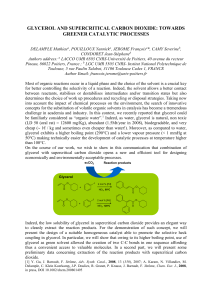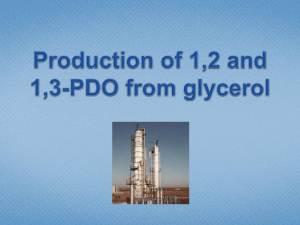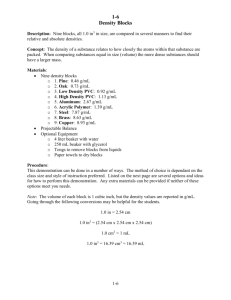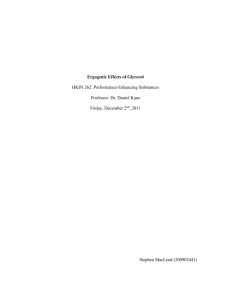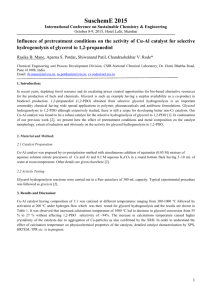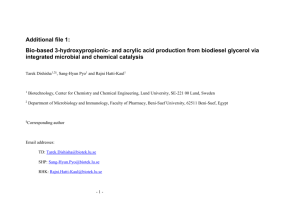Supporting Data6b
advertisement
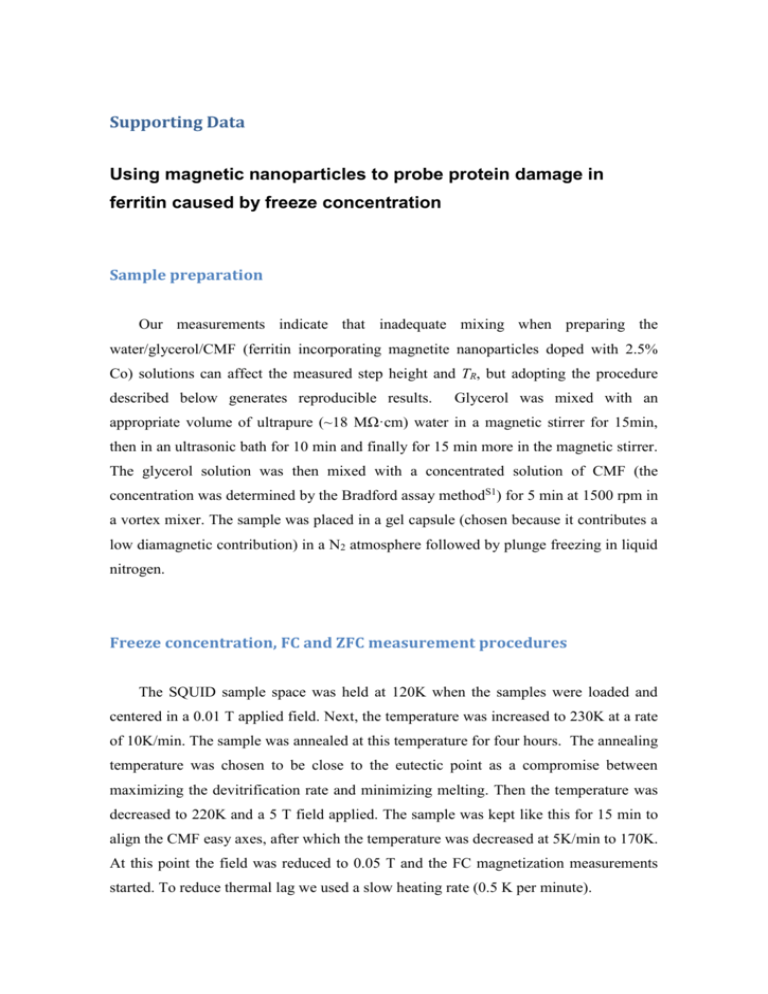
Supporting Data Using magnetic nanoparticles to probe protein damage in ferritin caused by freeze concentration Sample preparation Our measurements indicate that inadequate mixing when preparing the water/glycerol/CMF (ferritin incorporating magnetite nanoparticles doped with 2.5% Co) solutions can affect the measured step height and TR, but adopting the procedure described below generates reproducible results. Glycerol was mixed with an appropriate volume of ultrapure (~18 MΩ·cm) water in a magnetic stirrer for 15min, then in an ultrasonic bath for 10 min and finally for 15 min more in the magnetic stirrer. The glycerol solution was then mixed with a concentrated solution of CMF (the concentration was determined by the Bradford assay methodS1) for 5 min at 1500 rpm in a vortex mixer. The sample was placed in a gel capsule (chosen because it contributes a low diamagnetic contribution) in a N2 atmosphere followed by plunge freezing in liquid nitrogen. Freeze concentration, FC and ZFC measurement procedures The SQUID sample space was held at 120K when the samples were loaded and centered in a 0.01 T applied field. Next, the temperature was increased to 230K at a rate of 10K/min. The sample was annealed at this temperature for four hours. The annealing temperature was chosen to be close to the eutectic point as a compromise between maximizing the devitrification rate and minimizing melting. Then the temperature was decreased to 220K and a 5 T field applied. The sample was kept like this for 15 min to align the CMF easy axes, after which the temperature was decreased at 5K/min to 170K. At this point the field was reduced to 0.05 T and the FC magnetization measurements started. To reduce thermal lag we used a slow heating rate (0.5 K per minute). After completing the FC measurements at 230 K, the sample was warmed to 250K to randomize the easy axis orientations, before decreasing the temperature to 170K in zero applied field. The ZFC measurements were performed using the same parameters as the FC measurements. Figure S1 shows the FC and ZFC measurements for samples 1M-0.9, 50mM-0.9, 200mM-0.9, and 100mM-1.8. Figure S1 – FC and ZFC magnetic susceptibility measurements for samples (a) 1M-0.9, (b) 50mM-0.9, (c) 200mM-0.9, and (d) 100mM-1.8. Estimating the thickness of the fluid layer surrounding the protein assuming that changes in 𝑻𝑹 are due only to finite cavity size If we assume that the protein is a sphere, hydrodynamic radius 𝑎, surrounded by freeze-concentrated glycerol solution, its rotation is governed by the Stokes equation 𝜁 = 8𝜋𝜂𝑎3 . If the cavity surrounding the protein is finite, with radius (1 + 𝛿)𝑎 the equation is modified toS2: (1+𝛿)3 𝜁 = 8𝜋𝜂𝑎3 (1+𝛿)3 −1 , (S1) Note that the limit of this equation as δ → ∞ is the Stokes equation. The timescale for relaxation by Brownian rotation is a function of 𝜁/𝑘𝐵 𝑇. 𝑇𝑅 is the temperature at which this timescale approaches the timescale of the magnetization measurements. As the range of values of 𝑇𝑅 is small, we can assume that 𝜁 at 𝑇𝑅 always has approximately the same value. Hence at 𝑇𝑅 𝜂 (1+𝛿)3 (1+𝛿)3 −1 always has approximately the same value if a is constant. We assume that the viscosity 𝜂 of the freeze-concentrated solution that surrounds the protein is a function only of temperature. We also assume that 𝛿 → ∞ for sample 1M-0.9 (reference sample). We then calculate 𝛿 for sample X from (1+𝛿)3 (1+𝛿)3 −1 = 𝜂(𝑇𝑅 for reference sample) 𝜂(𝑇𝑅 for sample 𝑋) (S2) According to reference [S3] the maximum concentration of a freeze-concentrated glycerol/water solution is ~ 80% w/w glycerol. Table S1 presents the thickness of the liquid shell surrounding each protein if the glycerol concentration after freezeconcentration is (a) 70% and (b) 80% w/w (9.0 and 10.5 M respectively). We compare the shell thickness calculated from the volume of freeze-concentrated glycerol available to coat the proteins (“expected thickness”) and the thickness calculated from 𝑇𝑅 using equation (2). η(TR) is calculated using equation (16) of reference [S4] and we assume 𝑎 = 6 nm. The results obtained using equation (S2) are much too small (table S1), which leads us to conclude that finite cavity size is not the reason for the increase in 𝑇𝑅 and 𝑎 is not constant for all samples. TABLE S1 - Thickness of freeze-concentrated glycerol layer surrounding protein calculated for compositions of 70% and 80% w/w on the basis of either the volume of freeze-concentrated glycerol available (“expected thickness”) or equation (S2). Thickness of cryoprotectant layer (nm) Sample 80% glycerol- 80% 70% glycerol- 70% 20% water Expected 30% water Expected thickness thickness 200mM-0.9 0.31 14.5 0.4 15.4 100mM-1.8 0.015 7.3 0.025 7.9 50mM-0.9 0.026 7.3 0.04 7.9 25mM-0.45 0.003 7.3 0.006 7.9 50mM-3.6 0.001 3.0 0.002 3.4 DLS measurements We obtained the translational diffusion coefficient (𝐷𝑡 ) from dynamic light scattering (DLS) measurements using a Malvern ZetaSizer Nano ZS instrument. We prepared four different samples using CMF nanoparticles dispersed in ultrapure water and in glycerol solutions at three different concentrations: 1 M; 200mM and 50mM. Half of each sample was frozen by immersion in liquid nitrogen and thawed (i.e. subjected to a thermal treatment similar to the samples used in the magnetic measurements) while the remainder was measured as prepared (without any thermal treatment). All samples were filtered through a 220 nm filter to remove any aggregates, the temperature was 20 deg C, and the refractive indices used to calculate 𝐷𝑡 were adjusted with every glycerol/water mixture that was used. A folded capillary cell was used, and filled with approximately 1 mL of sample. Three measurements were performed per sample. The hydrodynamic radius can be obtained from the following equation: 𝑘 𝑇 𝐵 𝑅 = 6𝜋𝜂𝐷 𝑡 (S3) where kB is the Boltzmann constant; T is the temperature, η is the viscosity of the solution and Dt is the translational diffusion coefficient. We used equation (S3) to determine the percentage increase in the hydrodynamic radius 𝑎 between the freeze-thawed and untreated samples of each composition. Supporting data references M. M. Bradford, ‘A rapid and sensitive method for the quantitation of microgram quantities of protein utilizing the principle of protein-dye binding’, Anal. Biochem. 72, 248 (1976). S1 S2 A.P. Philipse, ‘Notes on Brownian Motion’, August 2011, http://userpages.umbc.edu/~dfrey1/ench630/philipse_notes_on_brownian_motion.pdf S3 S. Ablett, M. J. Izzard, and P. J. Lillford, ‘Differential scanning calorimetric study of frozen sucrose and glycerol solutions’, J. Chem. Soc. Faraday Trans., 88, 789 (1992). S4 J. A. Trejo González, M. P. Longinotti, and H. R. Corti, ‘The viscosity of glycerol- water mixtures including the supercooled region’, J. Chem. Eng. Data 56, 1397 (2011),

